Improve House Lighting with Solar Tubes
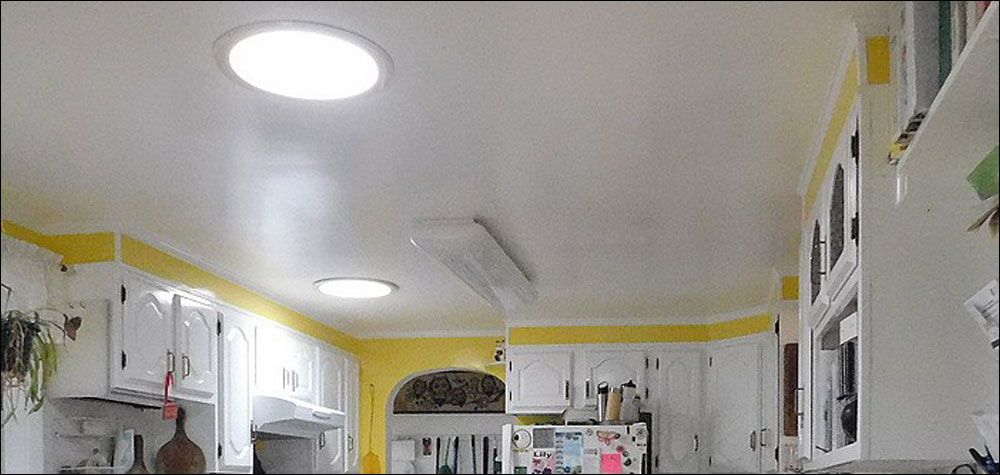
A solar tube is an odd thing to see in the wild. A skylight is obvious: it’s a big hole in your roof framed out like a window that lets sunlight pour in while excluding the rest of the great outdoors. Skylights tend to be large; several square feet or more. All that glass means a whole lot of free sunlight can come flooding in to light the room below.
A solar tube looks so small that it asks a question: How can a glass pane the size of a large dinner plate let in enough light to make it worth cutting a hole in your roof? And there is the fact the tube, which looks like an oversized dryer vent, ensures that the light has to travel a long way from your rooftop, through your attic, and thence into the room below. Surely light must be lost on the journey to the glass dinner plate set into your ceiling.
So the solar tube does seem questionable. They are expensive, need professional installation if you don’t want your roof to leak, and they don’t seem to offer nearly as much light as a skylight would.
In practice, they are tremendously useful.
When we bought our house, our kitchen was permanently dark. It has three windows; a large double-hung facing the neighbor’s house that does receive direct sun in the morning and two much smaller double-hung windows side by side over the sink that never receive direct sunlight as they open onto our Florida room. The backdoor opens onto the Florida room as well, but it doesn’t open into the kitchen. There’s a tiny foyer and light has to go around the corner through an arched entryway to reach the kitchen. In addition, all the kitchen cabinets were stained dark, dark cherry and the walls and ceilings were painted dull beige. So was the tiny backdoor foyer.
This means that we always had the kitchen lights on, no matter how sunny the day was outside. That room was always dim and gloomy.
The situation was the same in our main bathroom, as well as the upstairs bathroom. No matter the time of day, if you wanted to use the facilities, you had to have a light on.
Seduced by Solar Tubes
Bill and I saw solar tubes demonstrated at a home show and we were intrigued. They came in a variety of sizes, two styles of tubing, they could be wired to act as light fixtures, and they could also, for bathrooms, come with a ventilation fan. The dealers swore they wouldn’t leak. I collected information on them and when we got around to reroofing the house, we had four of them installed: two for the kitchen, and one for each of our bathrooms.
I bought the largest tubes that would fit between the joists without having to cut them: 14-inch-wide tubes. Both kitchen tubes are plain tubes; they have no light or ventilation kit. Tube one is near the sink and counter where we prep food. Tube number two is near the center of our eat-in kitchen so it complements the light that comes in through the windows.
The difference was literally like night and day. We no longer turn on the lights during the day unless the weather is bad or the tubes are buried in snow. When the moon is full, they even function as a nightlight. When Bill was working at the newspaper, he could come in at 2 a.m. and walk through the kitchen without turning on the lights.
To demonstrate the magic of the tubes, here’s some pictures Bill took of our kitchen on a typical, dreary December day in central Pennsylvania. They match what our eyes tell us. The first photo shows the kitchen lit only by the tubes.
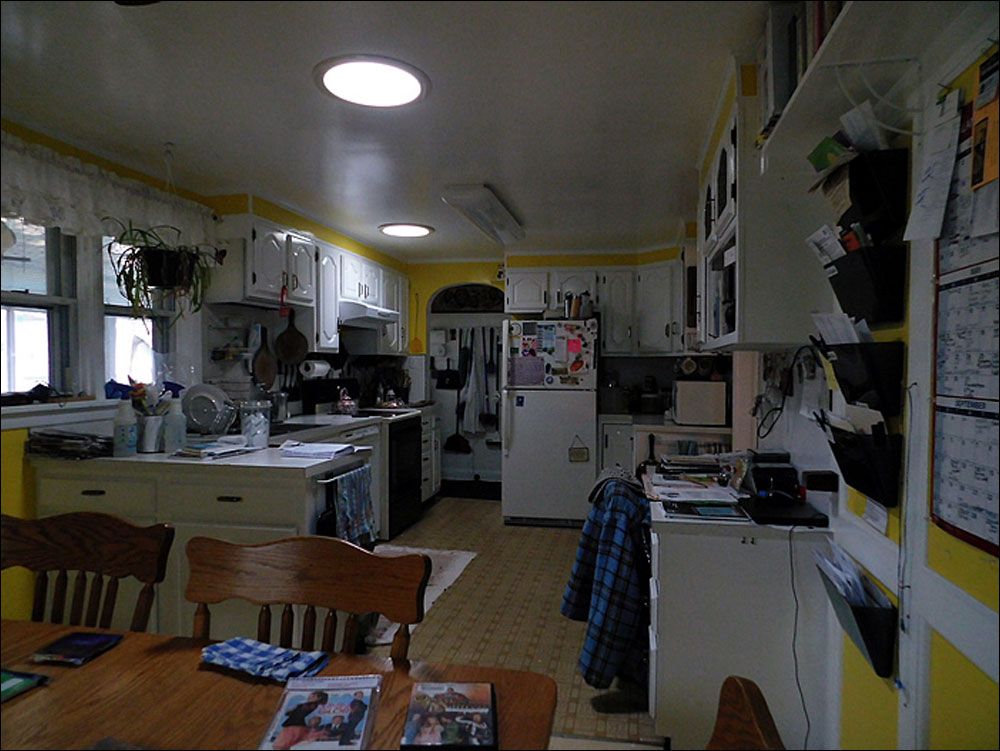
The next picture shows the same space with the tubes covered with cardboard. The kitchen goes from indifferently lit to sub-dungeon.
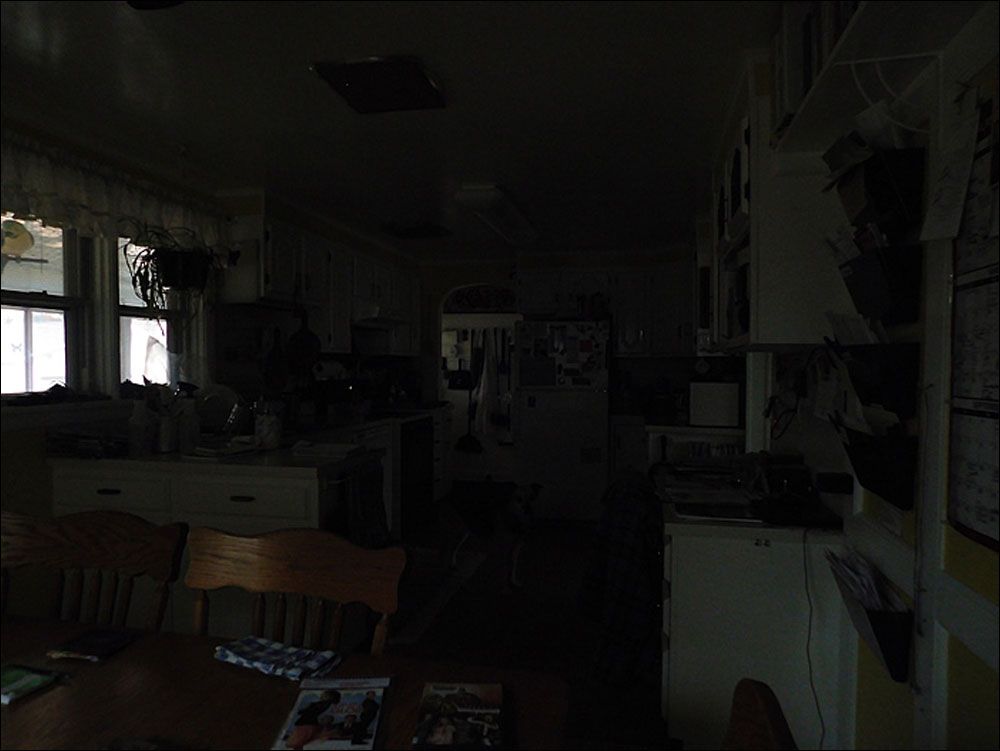
The two windows look out onto the Florida Room and do not receive direct sun. No other lighting is in use. Looks indifferent, doesn’t it? Kind of grim and gray. The tubes don’t look like they’re doing much until you see the room without them. What you aren’t seeing from the photos is that our kitchen was even darker when the tubes were first installed. The cabinets were still stained a dark, dark cherry. The walls and ceilings were flat dirty beige. The tubes lit up the space.
Then I painted the walls glossy Pikachu Yellow and the ceilings ultra-high-gloss white. The light from the tubes got brighter. Finally, Dear Daughter painted our cabinets with ultra-high-gloss white paint. The tubes got even brighter since they were no longer trying to light a dungeon. I expect when I replace the thirty-year-old dingy linoleum with shiny, white sheet vinyl, the kitchen will get even brighter.
Brightly painted walls, a white ceiling, white cabinets, and solar tubes make for a kitchen that’s never dark during the day.
Bringing Light Into Darkness
The tubes in the bathrooms both came with ventilation kits and the upstairs bathroom has an added light fixture. The bathrooms never need to have a light turned on during the day. Light from the main bathroom’s tube even spills into the hallway. This room does have a window, but the solar tube provides more light because of its orientation to the sun on the roof. The window only receives direct light early in the morning.

The upstairs bathroom is a very small, windowless room. After the tube was installed, if the door is left open, light spills into the adjacent bedroom. This bathroom was so dark that you could not walk inside it without turning on a light. No more, at least during the daytime. I could grow palm trees in those bathrooms, there’s so much light. I love these tubes. We’ve had them in place for over a decade now and have never had a problem.
As with the kitchen, the glass panel on the tube glows when there is a full moon in the night sky and give a soft glow that act as free nightlights.
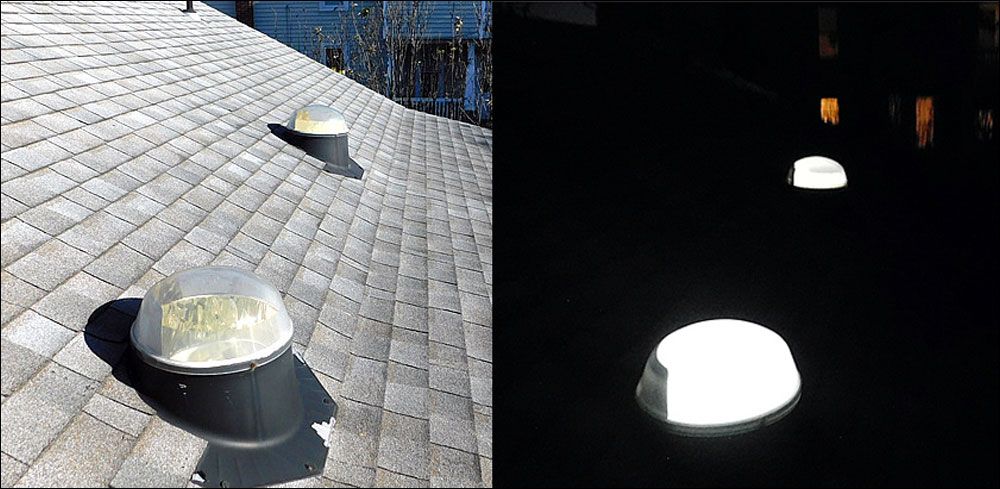
Solar Tube Design and Installation Advice
A solar tube doesn’t belong everywhere. Each one is a hole in the roof. You also don’t want this light pouring in everywhere. A tube in your living room or hallway makes it sunshiny and bright. A tube in your bedroom will get you up at dawn every morning, whether you want to or not. I would not install a tube in a closet as the unrelenting sunshine could fade your clothes; they are better off stored in the dark. Pantries don’t need this kind of light either, as food storage spaces should always be cool, dry, and dark.
I would put tubes in hallways, stairwells, offices, garages, and studios as well as kitchens, bathrooms, and living rooms. The sunshine makes everything more cheerful.
If you are considering how to increase your natural light levels in your home, then solar tubes may be the way to go. They are not cheap (several hundred dollars each depending on type of tube, size and complexity of add-ons) and, unless you are very skilled in the building trades, they are not a do-it-yourself project. You need open, clear attic access over the ceiling you want to install them in. If you are buying a tube with lighting or ventilation or both, you’ll need wiring access. The best time to install them, since they involve cutting holes in the roof, is when you replace the roof.
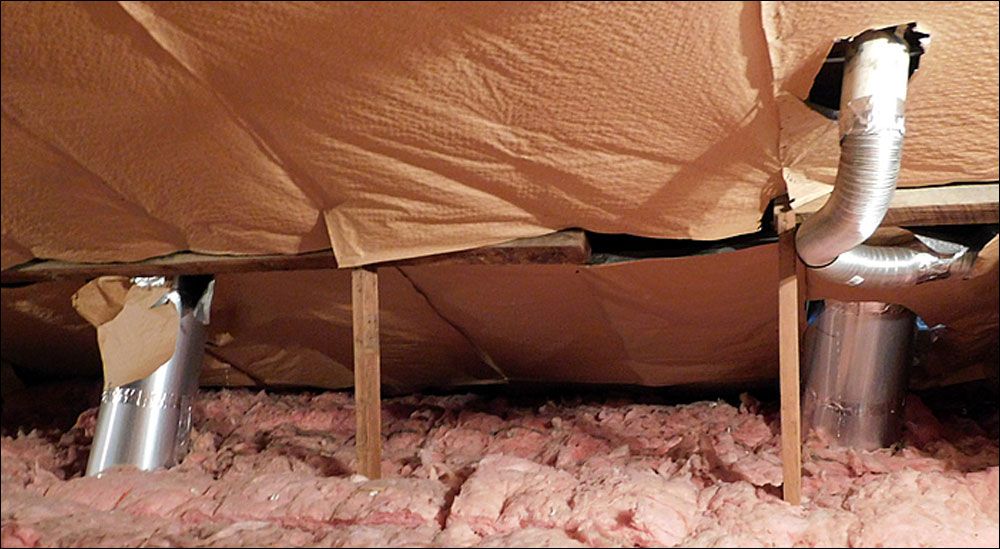
(My kitchen tubes. The right one is next to a vent from the stove.)
The tube itself comes in two types. Your attic access and the length between roof dome and ceiling plate help determine which you use.
The first type produces far more light because it is a giant pipe made from a sheet of smooth, highly polished aluminum. Sunlight bounces down the tube from the roof dome to the glass ceiling plate with very little light loss on the way. This tube is straight and won’t tolerate bending so you have to have a straight shot between roof dome and ceiling plate. It costs more. It doesn’t like being retrofitted around attic joists. It’s best installed in new construction when the builder can make sure there’s enough space.
Because we had short, clear space between the roof dome and the ceiling plate AND the house was being reroofed, Jake the Contractor was able to install the tubes without too much swearing and aggravation. Afterwards, he told me he wouldn’t do it again because it was still a challenge working in those tight spaces. The tubes are highly visible in the attics but because we don’t use those spaces other than for dead storage, I haven’t needed to build protective chases around them. They don’t seem to lose much heat in the winter, either. If we were further north, I would think about insulated boxes to prevent heat loss and protect the tubes.
The second type of tube is far easier to retrofit AND it’s less expensive to purchase. However, you won’t get nearly as much light. This tube looks like a super-highly polished aluminum dryer vent. It’s flexible and bendy so it can be worked around awkward corners. It’s lighter in weight so it can be used for longer runs between the roof dome and the ceiling plate. The interior is polished, but that bendy, corrugated interior just won’t reflect light the way a straight, smooth tube of polished sheet metal will. The roof dome, glass ceiling plate, and any light or ventilation kits are exactly the same as for the polished tube. If you don’t have easy, spacious attic access and a skinny, flexible contractor, you’ll have to use the dryer vent style. You’ll still enjoy free sunlight where you never thought it was possible.
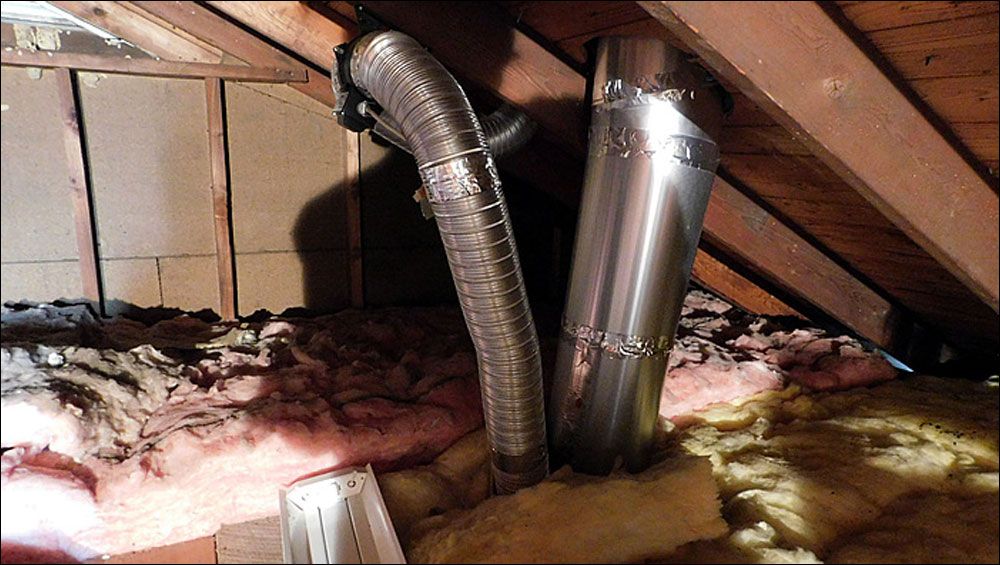
(My bathroom tube, with the corrugated vent)
Light kits and ventilation kits can be purchased. If you already have appropriate light fixtures, your new tubes don’t need them, so don’t pay for them. Bathrooms always benefit from more ventilation so think hard before saying no. Both lights and fans will need to be wired in and have on/off switches installed so your contractor will have to be experienced with electrical work.
If I could run a solar tube to our badly lit, finished basement, I would. Supposedly you can do this with a flexible dryer vent tube run through a chase built into a closet. We don’t have conveniently located closets nor can I figure out where to install a chase large enough to hold a tube. It would have to be constructed eighteen inches by eighteen inches square to hold and protect the tube needed for a fourteen-inch diameter plate.
Solar tubes have been a valuable part of my continuing efforts to get more light into our home and I highly recommend them. I love ours. They go a long, long way to keeping a central Pennsylvania winter from becoming even more gloomy and depressing than it already is. I could have bought a lot of electricity for what the solar tubes cost me, and I would do it again today. They make that much of a difference.
Comments
David Trammel
Wed, 11/06/2019 - 11:42
Permalink
Great Follow Up Post - Solar Tubes
Very nice follow up post Teresa, and I can see what a difference they make. They really are of a kind of improvement that Greer talks about all of the time, getting free energy. Much like solar water heating, after a relatively low initial cost (compared with something like solar electric panels), you should be able to receive a good return on your investment with little upkeep cost.
Love the photos too.
mountainmoma
Wed, 11/06/2019 - 21:27
Permalink
transformed the kitchen
Great post ! Lots of good pictures and explanations. I loves that you showed the attic areas.
I wish I could use them in my dark kitchen and downstairs bathroom, unfortunately, 2 story house and cant run them thru what is upstairs. Our plan is to open up an eating bar, so take off the upper part of the wall between the kitchen and dining , someday, to get more light back there.
As it is, for us, you can at least walk around the kitchen ( not chop ! ) when the power is out ( chopping is moved to the dining table) but the downstairs bathroom has to have a candle or other light source to be used. I like that your kitchen can be used with no electricity, if needed
You should tell us which brand you used.
Teresa from Hershey
Thu, 11/07/2019 - 12:47
Permalink
We used 'SolaTube' if I recall
We used (as near as I can recall) 'SolaTube'. There are many companies. I don't know the brand matters as much as installation. You are, after all, punching a hole in your roof.
A possibility for your kitchen is replacing the window with a bay window, the kind that is touted as a mini-greenhouse or plant location. I've seen them and they really do let in more light than a flat pane of glass. I'm not sure why. If you replace a window, don't get a smaller one! That defeats the purpose.
The other thing to do to improve your kitchen is paint every single flat surface including ceiling and cabinets with ultra-high gloss 100% pure white enamel latex paint. The kitchen brightens up amazingly.
Ultra-high gloss paint can be used on ANY wall in your house. The reason people don't is the shine: the walls look wet. The other reason is ultra-high gloss paint demands meticulous wall preparation. Every ding and dent will show.
That said, it looks gorgeous, like you've lacquered the walls. Light bounces around like inside a laser dome.
I don't normally paint my ceilings with other than ceiling white, but kitchens, bathrooms, and closets are an exception: ultra-high gloss paint is washable and ceiling white is not.
Unless you have a specific reason to do so, don't use any color other than 100% pure white. Adding pigment darkens the paint and reduces the light. I've painted an entire house in ultra-high gloss 100% pure white latex paint. This also makes the rooms look bigger.
Teresa from Hershey